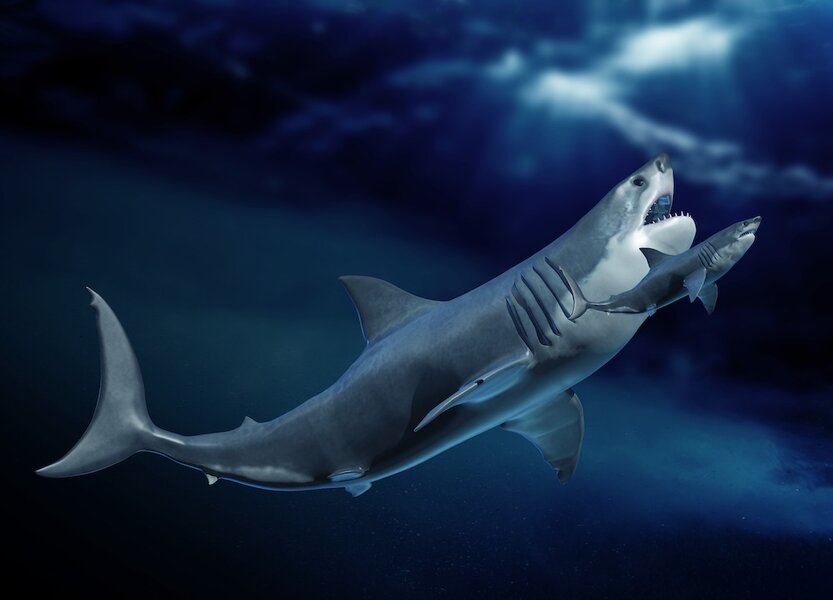Create a free profile to get unlimited access to exclusive videos, sweepstakes, and more!
Megalodons Were So Fearsome Because They Were Warm-Blooded
Maybe only *partially* warm-blooded.

When Peter Benchley set out to write his novel of a beachfront town under attack from a killer shark, there was only one living species that really fit the bill. There’s something about a great white shark which makes the hair stand up on the back of your neck. Maybe it’s that they get up to 20 feet long, of maybe it’s the jangled collection of razor sharp teeth attached to a jaw powerful enough to snap you in half. Maybe it’s both. Whatever it is, Jaws remains an important cultural touchstone nearly half a century after its release.
Great whites get so big, in part, because they are partially warm-blooded. Ramping up their body temperature means they can swim faster and cover a wider terrain, but it also means they have to keep eating. Keeping the internal fires running requires fuel. Great whites are plenty big to terrorize a sleepy tourist town, but it might have been so much worse if only we had lived a few million years ago.
Warm-blooded megalodons were more powerful and more vulnerable
Megalodons are the unequivocal ruler of all sharks, significantly larger than any sharks alive today. The great white is believed to be its closest living relative, but there are larger sharks still swimming the high seas. Basking sharks and whale sharks overshadow white sharks, but megalodon eclipsed them all. At their peak, between 23 million and 3.6 million years ago, sharks up to 50-feet long patrolled the world’s oceans in search of an endless seafood buffet. Scientists have wondered how the megalodon managed to get so large and how such a powerful apex predator could have been so completely wiped out. The answer to both of those questions comes down to temperature, according to a recent paper published in the Proceedings of the National Academy of Sciences.
RELATED: Megalodon Could Have Eaten a Killer Whale Whole
Researchers analyzed fossil megalodon teeth, looking for two particular isotopes: carbon-13 and oxygen-18. Their findings revealed the two isotopes clumped together in the teeth, suggesting they were formed at higher temperatures. Consequently, researchers have good reason to believe that megalodon was warm-blooded.
The analysis is consistent with an average internal body temperature of 80.6 degrees Fahrenheit, roughly 12 degrees higher than the ambient oceanic temperatures at the time. That’s pretty clear evidence that megalodon was at least partially warm-blooded, like the great white is today. Keeping their body temperature warmer may have made them more efficient hunters, but they would have needed to eat upward of 100,000 calories a day to break even. That’s fine as long as there’s plenty of food to go around, but high resource demands become problematic when the environment is in flux.
A few million years ago, temperatures and sea levels declined and the amount of food available in the oceanic food web might have declined. Suddenly, there wasn’t enough food to go around and these animals which were adapted for times of plenty were simply outcompeted by their slightly smaller relatives.
RELATED: Great whites might have pushed megalodons toward extinction
Researchers were clear that there are uncertainties in the data. It’s possible that megalodon was fully warm-blooded or only partially warm-blooded, focusing the extra warmth on critical places like the brain, eyes, and parts of the digestive system. That said, the estimated average body temperature of a megalodon sits somewhere between the wholly cold-blooded sharks and warm-blooded marine mammals who lived at the same time.
One of the big challenges inherent in this work is the uncertainty around megalodon’s morphology. At present, scientists have access to limited fossil evidence, comprised almost entirely of fossilized teeth. Our image of megalodon has to be extrapolated from that incredibly partial data and comparisons with living relatives. That’s why illustrations of megalodon almost always look like supersized great whites.
Failing a miraculously preserved specimen with intact soft tissues, there will likely always been more questions than answers when it comes to megalodon. But it’s almost magical how much we’re able to learn from disassociated teeth scattered across the ocean floor.
Revisit the first summer blockbuster with Jaws, available from Universal.



























